Lenovo Ideapad S540 (13) review – better than your MacBook Air
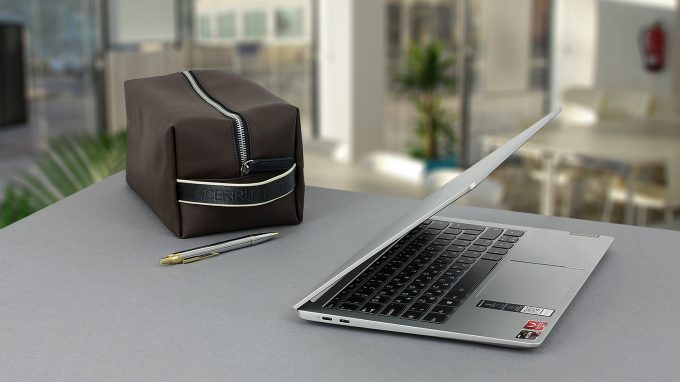 One of the strongest lineups from the Ideapad brand is surely the S540. The 15-inch version is very quick, has some great dedicated graphics options, and doesn’t drain your wallet at the same time. Now, the 13-inch model is very similar, but yet, a slight diversion from the others. It looks astonishing with the all-aluminum build and 1600p 16:10 display.
One of the strongest lineups from the Ideapad brand is surely the S540. The 15-inch version is very quick, has some great dedicated graphics options, and doesn’t drain your wallet at the same time. Now, the 13-inch model is very similar, but yet, a slight diversion from the others. It looks astonishing with the all-aluminum build and 1600p 16:10 display.
Actually, it is very reminiscent of some Apple devices, and it surely aims to beat the MacBook Air for your love. With that said, there are two versions of this notebook – they are physically the same, but what makes them different from one another is the chipset. The “13IML” version includes Intel Comet Lake processors, maxing out with the 6-core Core i7-10710U, while the “13API” models have AMD Ryzen 3000 CPUs. And not only that, but you can choose (or the head of marketing has chosen for you) between the H-series and the U-series Ryzen 5 and 7.
Now, let’s take a closer look at this device, and see how good (if any) a product this is.
You can check the prices and configurations in our Specs System: https://laptopmedia.com/series/lenovo-ideapad-s540-13/
Contents
Specs Sheet
- GPU
- NVIDIA GeForce MX250 (25W) #233 in Top GPUs Intel UHD Graphics #263 in Top GPUs AMD Radeon RX Vega 8 (R4000/5000, 15W) #232 in Top GPUs AMD Radeon RX Vega 8 (R2000/3000, 15W) #252 in Top GPUs AMD Radeon RX Vega 6 (R4000/5000, 15W) #251 in Top GPUs AMD Radeon RX Vega 10 #248 in Top GPUsAMD Radeon RX Vega 8 (R2000/3000, 35W)
- Display
- 13.3”, WQXGA (2560 x 1600), IPS
- HDD/SSD
- up to 2000GB SSD
- M.2 Slot
- 1x 2280 PCIe NVMe 3.0 x4 See photo
- RAM
- up to 16GB
- OS
- Windows 10 Pro, Windows 10 Home
- Battery
- 56Wh, 56Wh, 3-cell
- Body material
- Aluminum
- Dimensions
- 296.9 x 208.6 x 15.9 mm (11.69" x 8.21" x 0.63")
- Weight
- 1.30 kg (2.9 lbs)
- Ports and connectivity
- 2x USB Type-C
- 3.2 Gen 1 (5 Gbps), Power Delivery (PD), DisplayPort
- 1x USB Type-A
- 3.2 Gen 1 (5 Gbps)
- Card reader
- Ethernet LAN
- Wi-Fi
- 802.11ax
- Bluetooth
- 5.0
- Audio jack
- 3.5 mm combo
- Features
- Fingerprint reader
- Web camera
- HD
- Backlit keyboard
- Microphone
- Dual-Array Microphone
- Speakers
- 2x 2W, Dolby Audio
- Optical drive
- Security Lock slot
All Lenovo IdeaPad S540 (13″) configurations
What’s in the box?
Inside the package we found a 65W charging adapter with a USB Type-C connection. In addition to that, there are the mandatory paper manuals and the laptop itself. Nothing too exciting to talk about really.
Design and construction
In terms of build quality, we are talking about a very well constructed notebook. It has an all-aluminum chassis, which is susceptible to flexes and feels premium. The finish is smooth and resistant to fingerprints. Additionally, the Ideapad S540 (13) has a profile of 16mm and weighs only 1.25kg. This makes it a fairly portable little notebook, which will fit in pretty much every backpack.
Thankfully, its lid opens easily with a single hand, and the hinges are great. The experience we got was pretty similar to a MacBook with an easy to move lid with seemingly no resistance, but again, when you bump the laptop, the display just doesn’t move. Some black magic going on there for sure.
Next, there is the keyboard. It is a decent unit with clicky feedback and slightly shallow key travel – definitely something you can get used to. All in all, we are happy with it and its keycaps are pretty big. Well, except for the Enter key, which shares real estate with the parentheses (round brackets) key. Additionally, the Page Up and Page Down keys are now embedded into the Up and Down arrow keys. By the way, the keyboard deck has some bend, but it is only visible when you press hard on it.
Further below you can spot the touchpad. It is slightly bigger than the average for a Windows device. Additionally, it has a great gliding, thanks to the glass surface. Its buttons are embedded underneath the surface and need a relatively low amount of pressure to activate.
Lastly, on the bottom plate you can see a huge ventilation grill, as well as two speaker cutouts. Hot air, expectedly, comes out from in between the lid and the base.
Ports
Sadly, the I/O here is very limited. There are two USB Type-C 3.1 (Gen. 1) ports on the left. They can both be used for charging the laptop or to output a DisplayPort signal. Then, on the right, there is a single USB Type-A 3.1 (Gen. 1) port and an audio jack. There you can find the Power button as well.
Disassembly, upgrade options and maintenance
Getting inside of this notebook is easy, provided you have the right tools for the job. Its bottom panel is secured by 9 Torx-head screws. After you remove them, you can start the prying process from the backside of the panel. Then carefully move to the sides, and you should be able to easily lift it away.
Once you’re inside, you’ll see a pretty potent-looking cooling solution. There are two heat pipes, and two fans working hard to dissipate the heat from the processor. Keep in mind we have the AMD version here, and we all know the 3000-series Ryzen mobile processors are far easier to cool than their Intel counterparts.
As of the upgradability, as you can see, all of the memory is soldered to the motherboard. Pick your configurations wisely. On the bright side, there is a single M.2 PCIe x4 slot for fast storage.
Battery-wise, Lenovo has put a decent 56Wh unit inside of the Ideapad S540 (13).
Display quality
Lenovo Ideapad S540 (13) is equipped with a QHD HD IPS panel, MND307DA1-2 (CSO076D). Its diagonal is 13.3-inch (33.78 cm), and the resolution – 2560 x 1600p. Additionally, the screen ratio is 16:10, the pixel density – 227 ppi, their pitch – 0.11 х 0.11 mm. The screen can be considered Retina when viewed from at least 38 cm (from this distance, the average human eye can’t see the individual pixels).
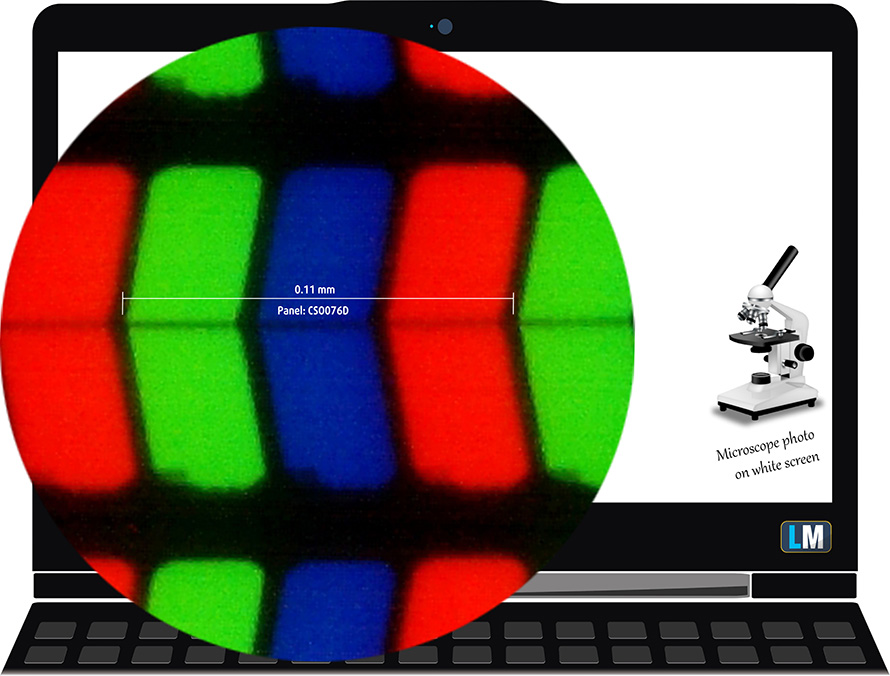
Viewing angles are comfortable. We offer images at different angles to evaluate the quality.

The maximum measured brightness is 313 nits (cd/m2) in the middle of the screen with a maximum deviation of only 3%. Here, we should say that the display of this notebook changes its brightness, depending on the content. The Correlated Color Temperature on a white screen and at maximum brightness is 7160K – colder than the 6500K temperature for sRGB.
In the illustration below you can see how the display performs from uniformity perspective. The illustration below shows how matters are for operational brightness levels (White level = 115 cd/m2, Black level = 0.09 cd/m2).
Values of dE2000 over 4.0 should not occur, and this parameter is one of the first you should check if you intend to use the laptop for color-sensitive work (a maximum tolerance of 2.0 ). The contrast ratio is excellent – 1460:1 (1260:1 after profiling).
To make sure we are on the same page, we would like to give you a little introduction to the sRGB color gamut and the Adobe RGB. To start, there’s the CIE 1976 Uniform Chromaticity Diagram that represents the visible specter of colors by the human eye, giving you a better perception of the color gamut coverage and the color accuracy.
Inside the black triangle, you will see the standard color gamut (sRGB) that is being used by millions of people in HDTV and on the web. As for the Adobe RGB, this is used in professional cameras, monitors, etc for printing. Basically, colors inside the black triangle are used by everyone and this is the essential part of the color quality and color accuracy of a mainstream notebook.
Still, we’ve included other color spaces like the famous DCI-P3 standard used by movie studios, as well as the digital UHD Rec.2020 standard. Rec.2020, however, is still a thing of the future and it’s difficult for today’s displays to cover that well. We’ve also included the so-called Michael Pointer gamut, or Pointer’s gamut, which represents the colors that naturally occur around us every day.
The yellow dotted line shows Lenovo Ideapad S540 (13)’ color gamut coverage.
Its display covers 94% of the sRGB/ITU-R BT.709 (web/HDTV standard) in CIE1976, providing a punchy and vibrant image.
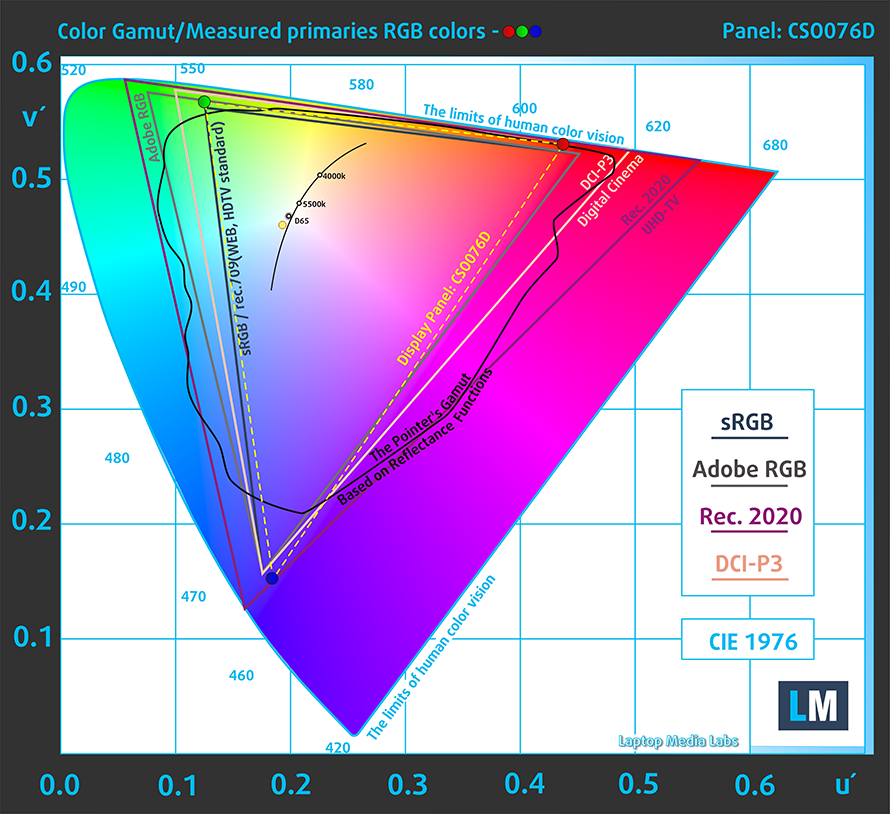
Our “Design and Gaming” profile has a target point of D65 (Illuminant white point – D65) at 140 cd/m2 and sRGB gamma mode.
We tested the accuracy of the display with 24 commonly used colors like light and dark human skin, blue sky, green grass, orange, etc. You can check out the results at factory condition and also, with the “Design and Gaming” profile.
Below you can compare the scores of Lenovo Ideapad S540 (13) with the default settings (left), and with the “Gaming and Web design” profile (right).
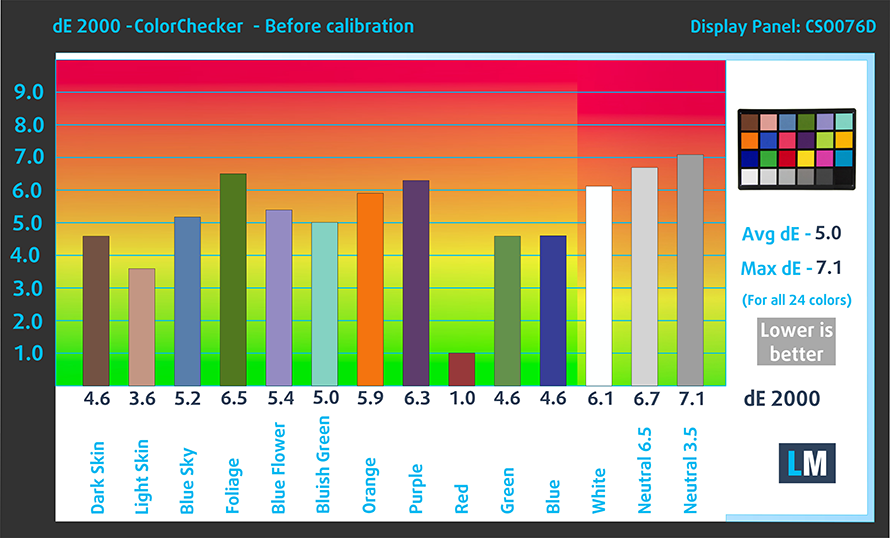

The next figure shows how well the display is able to reproduce really dark parts of an image, which is essential when watching movies or playing games in low ambient light.
The left side of the image represents the display with stock settings, while the right one is with the “Gaming and Web Design” profile activated. On the horizontal axis, you will find the grayscale and on the vertical axis – the luminance of the display. On the two graphs below you can easily check for yourself how your display handles the darkest nuances but keep in mind that this also depends on the settings of your current display, the calibration, the viewing angle, and the surrounding light conditions.

Response time (Gaming capabilities)
We test the reaction time of the pixels with the usual “black-to-white” and “white-to-black” method from 10% to 90% and vice versa.
We recorded Fall Time + Rise Time = 19 ms.
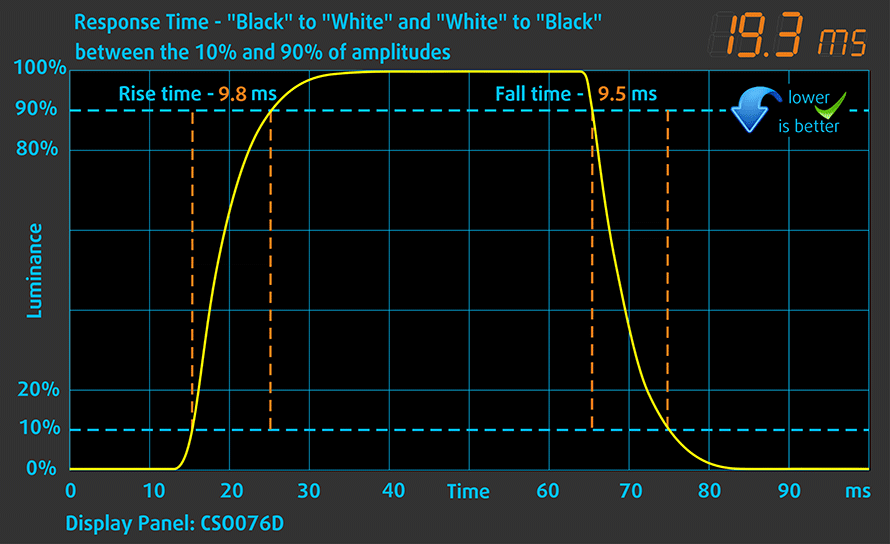
Health impact – PWM / Blue Light
PWM (Screen flickering)
Pulse-width modulation (PWM) is an easy way to control monitor brightness. When you lower the brightness, the light intensity of the backlight is not lowered, but instead turned off and on by the electronics with a frequency indistinguishable to the human eye. In these light impulses, the light/no-light time ratio varies, while brightness remains unchanged, which is harmful to your eyes. You can read more about that in our dedicated article on PWM.
Lenovo Ideapad S540 (13) doesn’t use PWM to adjust its brightness levels at any brightness level. Hence, the laptop is safe for use for long periods of time in this aspect.
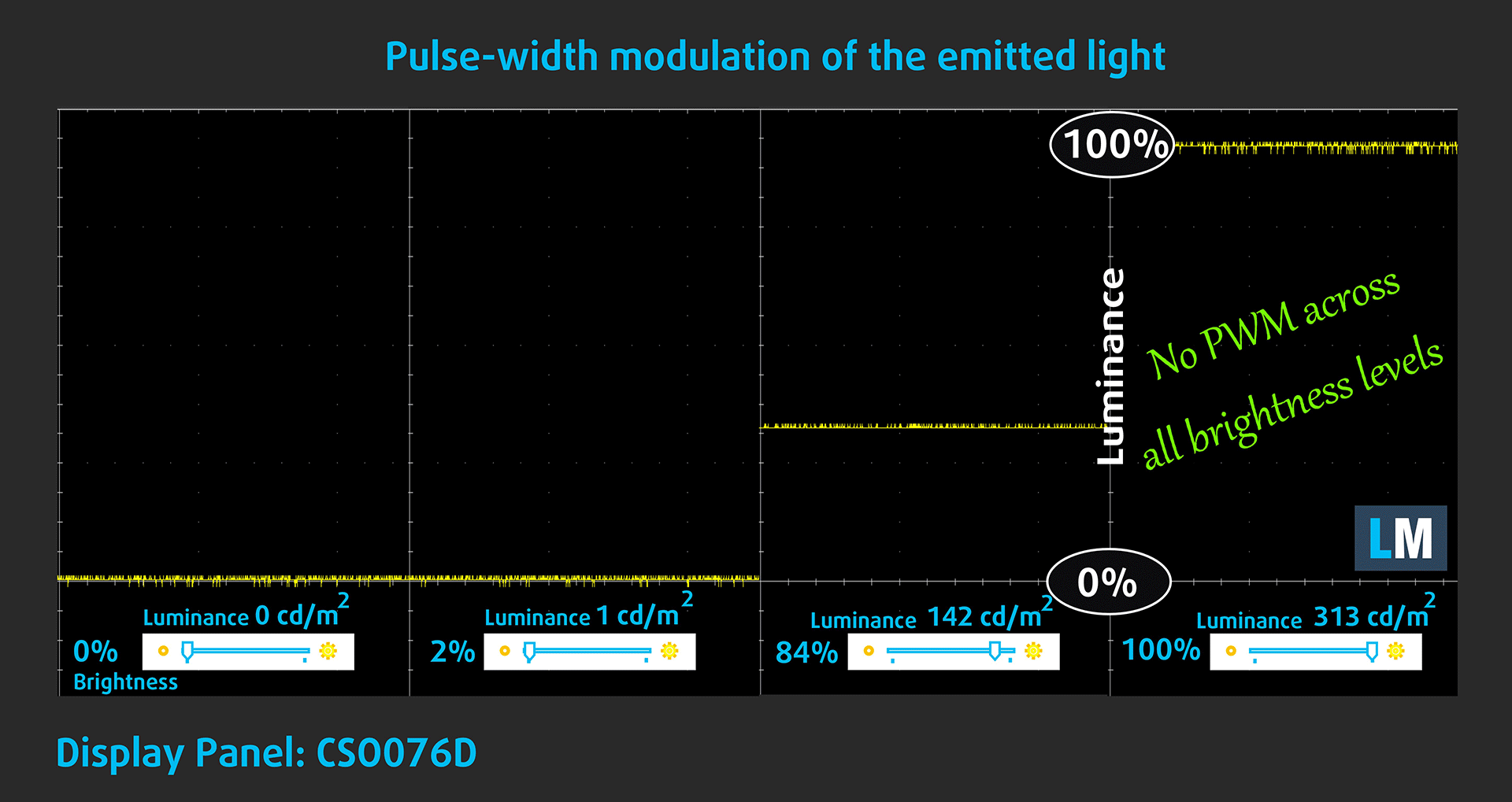
Blue light emissions
Installing our Health-Guard profile not only eliminates PWM but also reduces the harmful Blue Light emissions while keeping the colors of the screen perceptually accurate. If you’re not familiar with the Blue light, the TL;DR version is – emissions that negatively affect your eyes, skin, and your whole body. You can find more information about that in our dedicated article on Blue Light.
Conclusion
Lenovo Ideapad S540 (13)’s display has a QHD IPS panel with a good contrast ratio, comfortable viewing angles, and 94% sRGB coverage. Additionally, it doesn’t use PWM to adjust its brightness levels, which makes it comfortable for long work periods. Then again, the only disadvantage is the slightly bad color accuracy, which, by the way, is significantly improved with our Gaming and Web design profile. However, it still falls short of the desired dE value of <2.0.
Buy our profiles
Since our profiles are tailored for each individual display model, this article and its respective profile package are meant for Lenovo Ideapad S540 (13) configurations with 13.3″ MND307DA1-2 (CSO076D) (FHD, 1920 × 1080) IPS panel.
*Should you have problems with downloading the purchased file, try using a different browser to open the link you’ll receive via e-mail. If the download target is a .php file instead of an archive, change the file extension to .zip or contact us at [email protected].
Read more about the profiles HERE.
In addition to receiving efficient and health-friendly profiles, by buying LaptopMedia's products you also support the development of our labs, where we test devices in order to produce the most objective reviews possible.

Office Work
Office Work should be used mostly by users who spend most of the time looking at pieces of text, tables or just surfing. This profile aims to deliver better distinctness and clarity by keeping a flat gamma curve (2.20), native color temperature and perceptually accurate colors.

Design and Gaming
This profile is aimed at designers who work with colors professionally, and for games and movies as well. Design and Gaming takes display panels to their limits, making them as accurate as possible in the sRGB IEC61966-2-1 standard for Web and HDTV, at white point D65.

Health-Guard
Health-Guard eliminates the harmful Pulse-Width Modulation (PWM) and reduces the negative Blue Light which affects our eyes and body. Since it’s custom tailored for every panel, it manages to keep the colors perceptually accurate. Health-Guard simulates paper so the pressure on the eyes is greatly reduced.
Get all 3 profiles with 33% discount
Sound
Lenovo Ideapad S540 (13)’s speakers deliver decent quality audio. Its low, mid, and high tones all have some slight deviations in clarity.
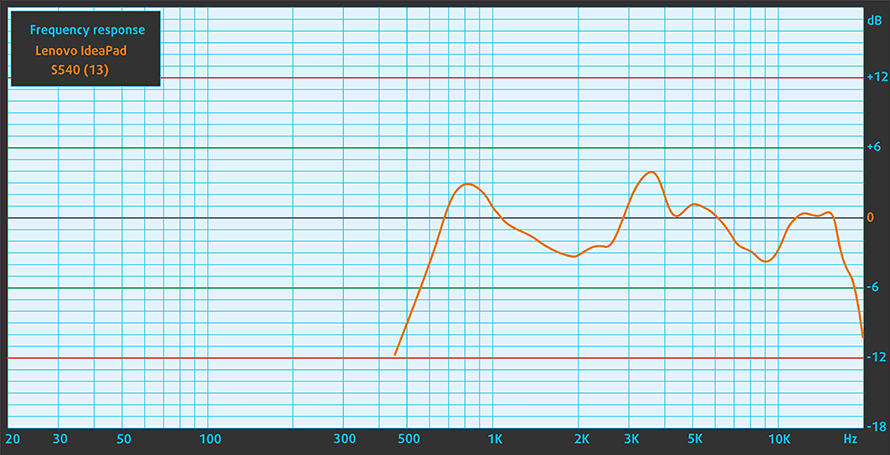
Drivers
All of the drivers and utilities for this notebook can be found here: https://pcsupport.lenovo.com/us/en/products/laptops-and-netbooks/ideapad-s-series-netbooks/s540-13api/downloads/driver-list
Battery
Now, we conduct the battery tests with Windows Better performance setting turned on, screen brightness adjusted to 120 nits, and all other programs turned off except for the one we are testing the notebook with.
In order to simulate real-life conditions, we used our own script for automatic web browsing through over 70 websites.
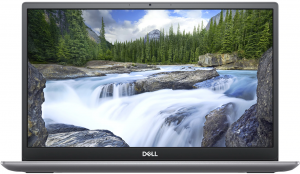
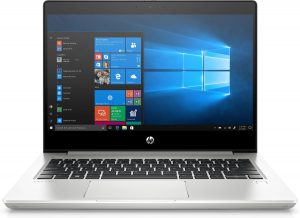
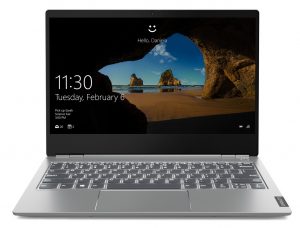
For every test like this, we use the same video in HD.



CPU options
Lenovo is offering this device with a handful of processor options. Some of them are part of the Comet Lake family by Intel, and others are made by AMD. Let’s start with the former ones. You will find Intel-equipped devices by the “13IML” designation. Ultimately, you can choose between all of the processors found in this lineup – starting from the Core i3-10110U, all the way to the six-core Core i7-10710U.
If you prefer AMD, on the other side, you can choose between four AMD Ryzen 3000 CPUs. They are the Ryzen 5 and Ryzen 7 from both the U and the H-series (Ryzen 5 3500U, Ryzen 5 3550H, Ryzen 7 3700U, Ryzen 7 3750H).
Results are from the Cinebench 20 CPU test (the higher the score, the better)
Results are from our Photoshop benchmark test (the lower the score, the better)
GPU options
GPU-wise, things are pretty straightforward. Intel’s machines will get the Intel UHD Graphics, while the AMD ones come with the Radeon Vega 8 and 10. However, the one dressed in blue comes with an NVIDIA GeForce MX250 with 2GB of GDDR5 memory. And the rumor says that the GeForce MX350 is an option as well.
Results are from the 3DMark: Fire Strike (Graphics) benchmark (higher the score, the better)
Results are from the Unigine Superposition benchmark (higher the score, the better)
Gaming tests

| CS:GO | HD 1080p, Low (Check settings) | HD 1080p, Medium (Check settings) | HD 1080p, MAX (Check settings) |
|---|---|---|---|
| Average FPS | 100 fps | 68 fps | 50 fps |

| DOTA 2 | HD 1080p, Low (Check settings) | HD 1080p, Normal (Check settings) | HD 1080p, High (Check settings) |
|---|---|---|---|
| Average FPS | 106 fps | 68 fps | 36 fps |
Temperatures and comfort
Max CPU load
In this test we use 100% on the CPU cores, monitoring their frequencies and chip temperature. The first column shows a computer’s reaction to a short load (2-10 seconds), the second column simulates a serious task (between 15 and 30 seconds), and the third column is a good indicator of how good the laptop is for long loads such as video rendering.
Average core frequency (base frequency + X); CPU temp.
| AMD Ryzen 5 3550H (35W TDP) | 0:02 – 0:10 sec | 0:15 – 0:30 sec | 10:00 – 15:00 min |
|---|---|---|---|
| Lenovo Ideapad S540 (13) | 3.05 GHz (B+45%) @ 66°C | 2.91 GHz (B+39%) @ 67°C | 2.65 GHz (B+26%) @ 65°C |
Well, wow. We saw some respectable frequencies from this device, at an incredibly low temperature for a 13-inch ultrabook. Keep in mind we are not talking about a U-series processor, but a beefier H-series one.
Comfort during full load
When it comes to noise and outer temperatures, the notebook seems quite loud under load, and while the keyboard may seem a little warm, it is nothing to dramatize for.

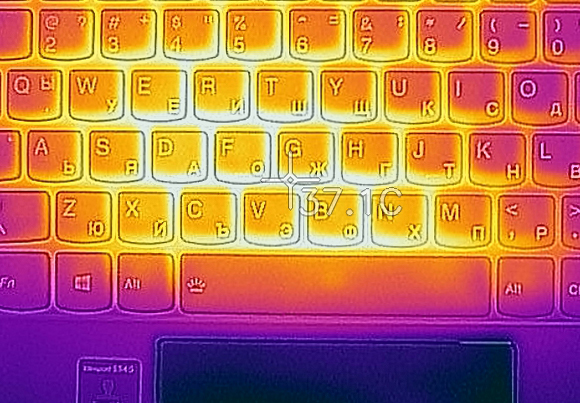
Verdict
 A very well executed machine. This is what best describes the Ideapad S540 (13). Of course, you are going to find some shortcomings like the lack of Thunderbolt connection, a modest I/O overall, and soldered memory. However, there are some fresh ideas implemented here, like the USB Type-C charging, excellent hinge, which provides an easily openable lid with a single hand and a stable position when opened.
A very well executed machine. This is what best describes the Ideapad S540 (13). Of course, you are going to find some shortcomings like the lack of Thunderbolt connection, a modest I/O overall, and soldered memory. However, there are some fresh ideas implemented here, like the USB Type-C charging, excellent hinge, which provides an easily openable lid with a single hand and a stable position when opened.
Additionally, we observed a good build quality, with an all-aluminum design, light chassis, and thin profile. In fact, it gives the users a premium feel, despite the reasonably low price tag.
Lenovo Ideapad S540 (13)’s display has a QHD IPS panel (MND307DA1-2) with a good contrast ratio, comfortable viewing angles, and 94% sRGB coverage. Additionally, it doesn’t use PWM to adjust its brightness levels, which makes it comfortable for long work periods. Then again, the only disadvantage is the slightly bad color accuracy, which, by the way, is significantly improved with our Gaming and Web design profile. However, it still falls short of the desired dE value of <2.0.
Honestly, this is probably one of the best parts of this device. But let’s not forget the PCIe x4 drive support and very good cooling solution, providing great performance for an ultrabook.
If all you really want is a thin and light, versatile notebook that will be your companion in pretty much everything you do, then the Ideapad S540 (13) is a great choice. While the 9 hours of Web browsing and 10 hours of video playback is good from the battery, we’ve seen better, especially in the ultrabook market. And if you need more I/O, better upgradability, or for some reason, you just don’t like Lenovo, the ProBook 430 G7 is a decent option.
Pros
- Thin and light all-aluminum body with a premium feel and great hinge mechanism
- 16:10 QHD crisp display with a good contrast ratio and comfortable viewing angles (MND307DA1-2)
- Covers 94% of sRGB (MND307DA1-2)
- Good battery life
- Doesn’t use PWM (MND307DA1-2)
- Performs good and remains cool even in extreme loads
- USB Type-C charging
Cons
- Modest I/O selection with no Thunderbolt support and lack of an SD card reader
- Poor upgradability
You can check the prices and configurations in our Specs System: https://laptopmedia.com/series/lenovo-ideapad-s540-13/

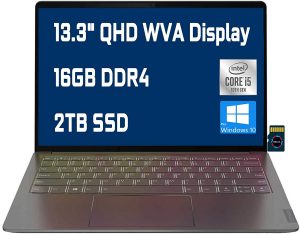


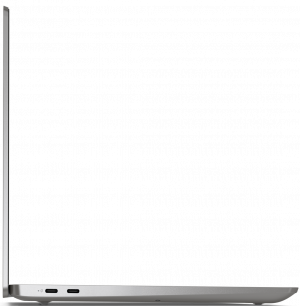
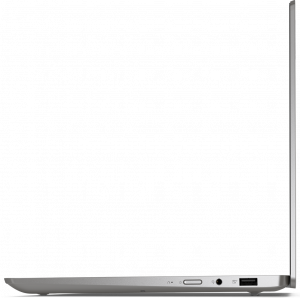

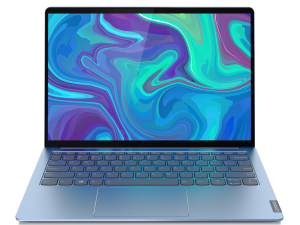

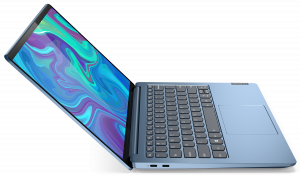

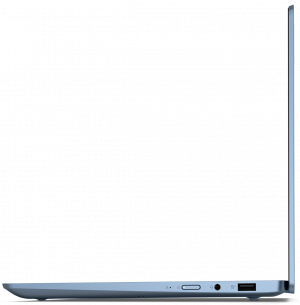
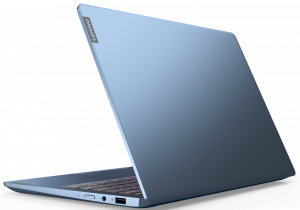
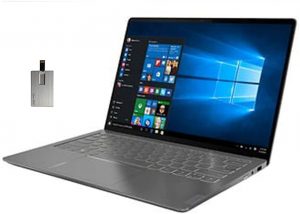
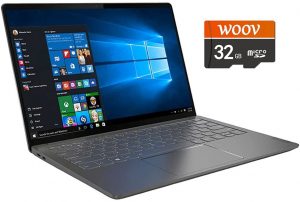
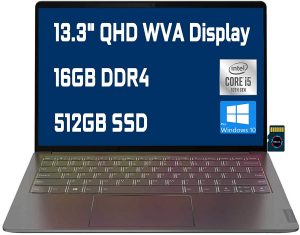
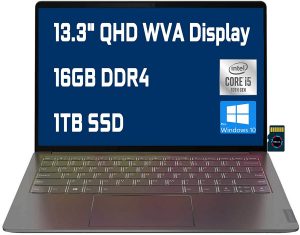

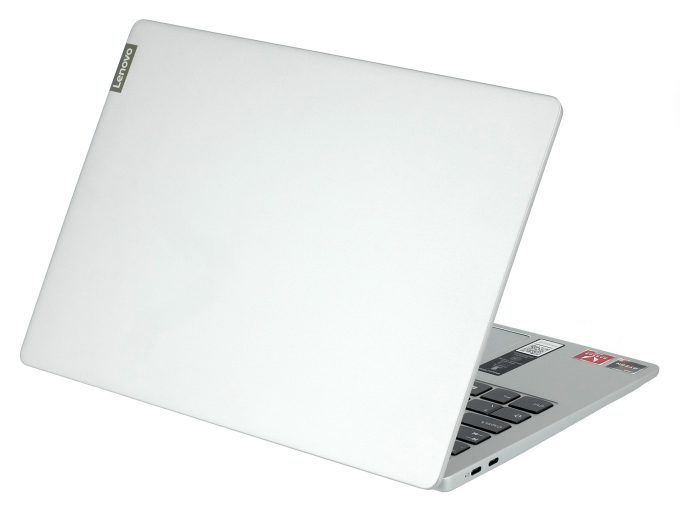
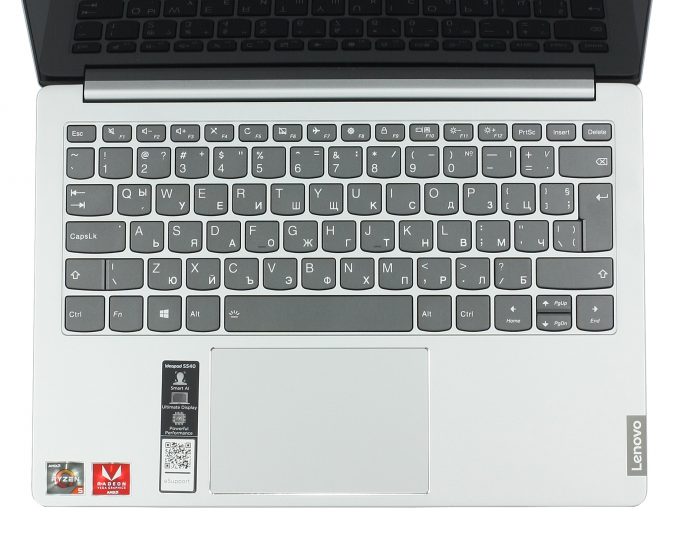
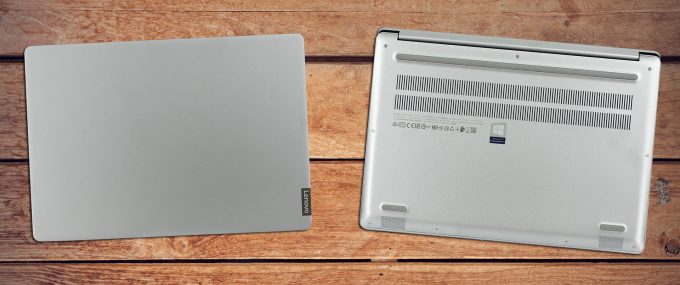


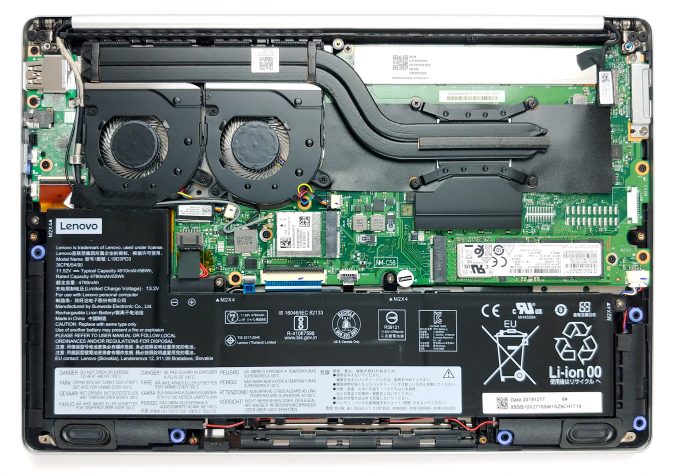
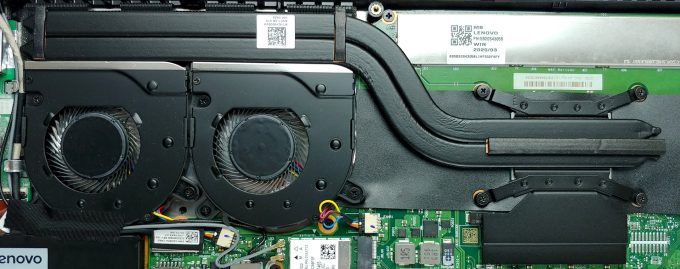
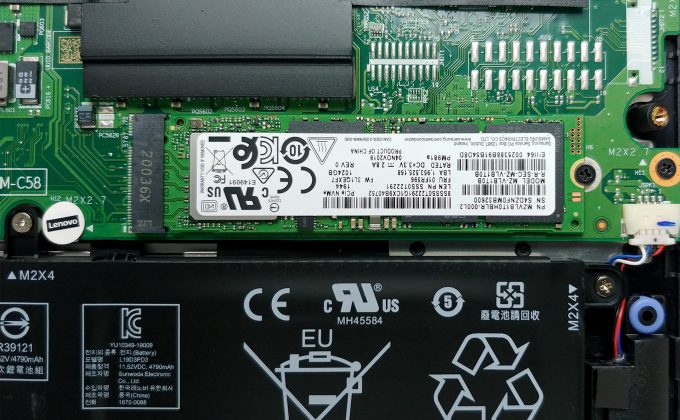



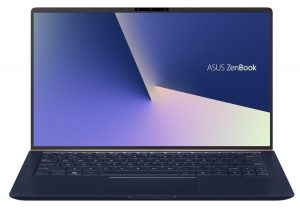
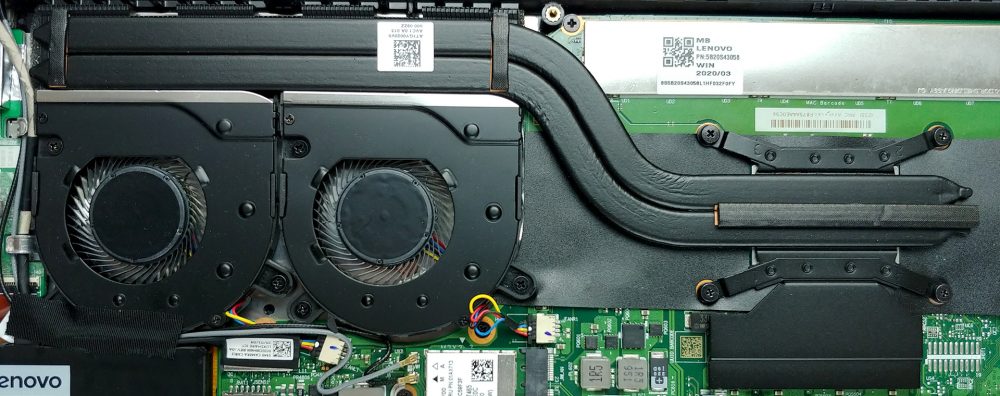








Hello
Would you please comment on the screen bleeding? Has it been tested?
Thanks
There is no screen bleed at all.
While I mostly agree with the results, one should mention that due to the highly reflective screen 120 nits is not nearly enough to get work done on this laptop unless you reside in some 200m deep cave. You would struggle even in average daylight conditions. As far as I can tell, you would have to operate on near max brightness, especially if the sun peaks through. Also better battery mode reduces max brightness. So these battery tests here are pretty much irrelevant in daily real life use. Especially at better performance mode I’ve never seen more than 3-4h when… Read more »
I was not impressed with the keyboard at all. Too soft and not enough feedback, too easy to make typing mistakes. Also it gets very hot when using if you like to sit it on your lap.
Sir/Mam,
I wanted to know what software do you use while stress testing the software for checking temp, frequency. Because i have stress tested my system which has core i5 10th gen. It’s Frequency remained at 3.4 to 3.5ghz and the power the processor were consuming was 32 to 33 watt. Temp was around 80_82.
Hello, I’m trying to decide between a ryzen 7 3750H configuration and an i7-10510U, and was wondering if you could provide any insight/information. I am more concerned about thermal issues and battery life with this laptop. Would you know if a 3750H with a tdp of 35W is a better option than the i7-10510U with a tdp of 15? I’m more inclined to go for the ryzen chipset as it is a lot cheaper, however am considering both configs. As the laptop you reviewed is a ryzen 5 configuration, I’m unsure if the ryzen 7 will give worse, similar, or… Read more »
..
Can lenovo IdeaPad s540 13inch can do data mining tasks
If I buy with 8GB of RAM, can I upgrade to 16GB of RAM?
no